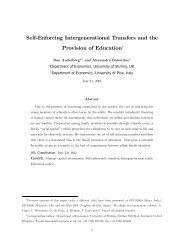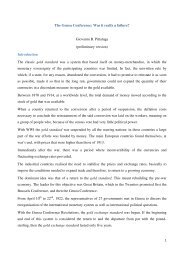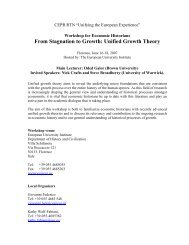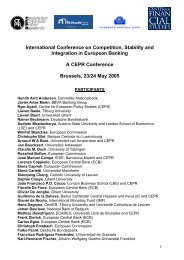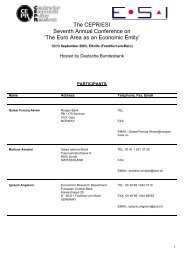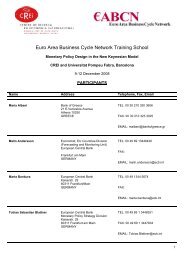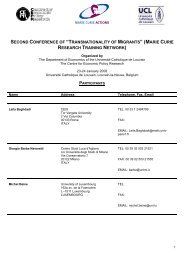MARKET STRUCTURE AND ENTRY: WHERE'S THE BEEF? - CEPR
MARKET STRUCTURE AND ENTRY: WHERE'S THE BEEF? - CEPR
MARKET STRUCTURE AND ENTRY: WHERE'S THE BEEF? - CEPR
You also want an ePaper? Increase the reach of your titles
YUMPU automatically turns print PDFs into web optimized ePapers that Google loves.
estimator (see e.g. Hajivassiliou, 1997, for a recent exposition 20 ). We opted for MSL<br />
instead of simulated method of moments (MSM) or some other simulation estimator for<br />
reasons explained by Hajivassiliou (1997) and endorsed by Hyslop (1999). The<br />
distribution of our dependent variable is relatively skewed (see Section 3), and MSL has<br />
proven more robust than other simulation-based estimation methods in such<br />
circumstances.<br />
Given that the time-invariant component of the error term is in S(.), leading to a<br />
model with random coefficients, we operationalize the simulation estimator by taking R<br />
(R = the number of simulation draws) times NT (the number of observations)<br />
independent draws of pseudo random numbers for the error terms ηj and (if necessary) 21<br />
εijt (i.e. the time-invariant, market specific, and the i.i.d. component of the error vector)<br />
from a standard normal distribution. We employ a decomposition simulation estimator<br />
(see e.g. Stern, 1997), setting R=40, and use antithetics. 22 We performed a small scale<br />
Monte Carlo simulation study (described in the Simulation Appendix which is available<br />
upon request) to ascertain that our estimator performs well with the assumed error<br />
structure, and this turned out to be the case. In particular, the simulation exercise<br />
revealed that the correct assumption as to where the random effect enters the<br />
specification is crucial for the performance of the estimator. For this reason, we also<br />
tested the robustness of our results for the standard assumption of the random effect,<br />
namely that it is additively separable (and therefore, in our specification, part of the fixed<br />
costs of entry). 23 The simulation study also revealed that not allowing for random effects<br />
when they are present leads to badly biased point estimates.<br />
A solution to the second problem is in many ways crucial to the interpretation of<br />
our results, especially if there turn out to be unobserved market specific factors that affect<br />
23



